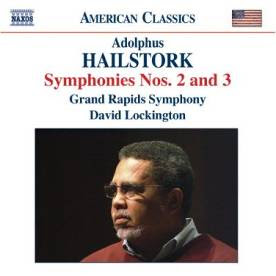[Adolphus Hailstork: Symphonies Nos. 2 and 3; Grand Rapids Symphony; David Lockington, Conductor; Naxos 8.559295 (2007)]
The 3 Hailstork Symphonies - more to follow, I hope!
By Mike S. Wright, Chair, International Society for African to American Music
As promised, I have been much impressed with Professor Adolphus Hailstork's Symphonies 2 and 3 which are on Naxos 8.559295. I especially feel that the Grand Rapids Symphony and the British-born conductor David Lockington have done a really magnificent job.
Before discussing the latest CD, I must firstly go back to TROY 104 which was a very commendable effort 15 years ago by Jullius P Williams. Hailstork's Symphony No 1 was proclaimed as such (not just 'Symphony') and after hearing it, was convinced that there would be more following. Don't underestimate this first symphony which is a mature work very much in classical form with a wonderful slow movement motivated by a haunting folk melody. Whilst I now realise that the orchestra that Williams had in the 1993 recording were at times struggling, the sheer quality of Hailstork's work was clear. This was not my first encounter with Hailstork's music. This was 'Celebration' which appeared on the belated and (as it turned out) final volume of the much appraised CBS Black Composer's series. Not only his unusual name but the sheer concentrated energy in that work made me remember what to expect when TROY 104 came out.
This now sets the scene for my words on this latest NAXOS CD which must firstly ask the company and distributors one question. Why did I have to import a copy to the UK as I have had to do so previously when it came to the 'American Classics' series and indeed some others by the same company and their now defunct Marco Polo label.
Now to the 2nd Symphony which (rather oddly) follows the 3rd on the disc. From the opening Allegro, listeners of the 1st symphony would soon recognise the strong Hailstorkian musical voice and distinctly American feel to the work. The wow factor of fine orchestration was right there and one could imagine that if William Grant Still was alive, he would have much approved. I was most intrigued by the fact that Professor Hailstork had visited Ghana and one of the slave forts along the coast during summer 1996. Coincidentally, I visited Ghana about the same time (June 1996) and went to one of these at Cape Coast and it was enough to make me cry. However, I did not spot or bump in to Professor Hailstork in the dark dungeons! Whilst these dungeons were smartened up with strategically placed lighting to give more tourist appeal, I hope that this did not blunt the composers' thoughts after his visit. The second movement, introduced by a 'spiritual-like' theme on the Cor Anglais, conveyed some of the emotion that he must have felt as he entered those dark dungeons that led to a narrow exit to the sea where the slaves were incarcerated into the hold of the ships. Yes, you could hear cries and the rumble of the sea swell breaking as it does close by the exit. However, I feel that it could have been even more intense - a voice perhaps. The following movement marked Allegro con brio was rather a misnomer - perhaps it needed vent more anger rather than turmoil perhaps on the line of Vaughan Williams 4th symphony. The final movement introduced by a clarinet is perhaps a little long. Gradually the scene changes and it heads into a happier mood with triumphal ending. Perhaps a little more uncertainty in the form of a quieter recapitulation at the end may (in my view) have made this fine symphony even more powerful.
The third symphony is a musical triumph and I have the feeling that this could 'travel' well (Naxos and other distributors and concert producers note!) outside the US. This could well be Hailstork's big access point outside America and it owes nothing to atonalism, minimalism and other transient fashions or indeed anything except the fact that this is good music. In the first movement, I am initially reminded of Chavez, perhaps even Aaron Copland but then the strong angular Hailstorkian voice breaks through and include some lovely instrumental obligatos which the members of the orchestra give their best. Hailstork is an undoubted master of choral music and this is reflected in the string writing of the 2nd movement which is sometimes almost pastoral with high points and a wonderful quiet ending. The short scherzo rattles along giving much excitement with some interesting tuned percussion effects and blues inspired fragments. The finale which draws on material at the beginning really draws this symphony together in a way that makes the work much more homogenous than the 2nd symphony. For the sake of repeating myself, I expect to hear many more performances and recordings of this work and look forward to more symphonies of this calibre from ANY composer.
And a word for the orchestra and Maestro - BRAVO
Adolphus Cunningham Hailstork
African American Composer
Symphonies 2 & 3
Naxos 8.559295
Grand Rapids Symphony
David Lockington Conductor




No comments:
Post a Comment